© 2025 ALLCITY Network Inc.
All rights reserved.

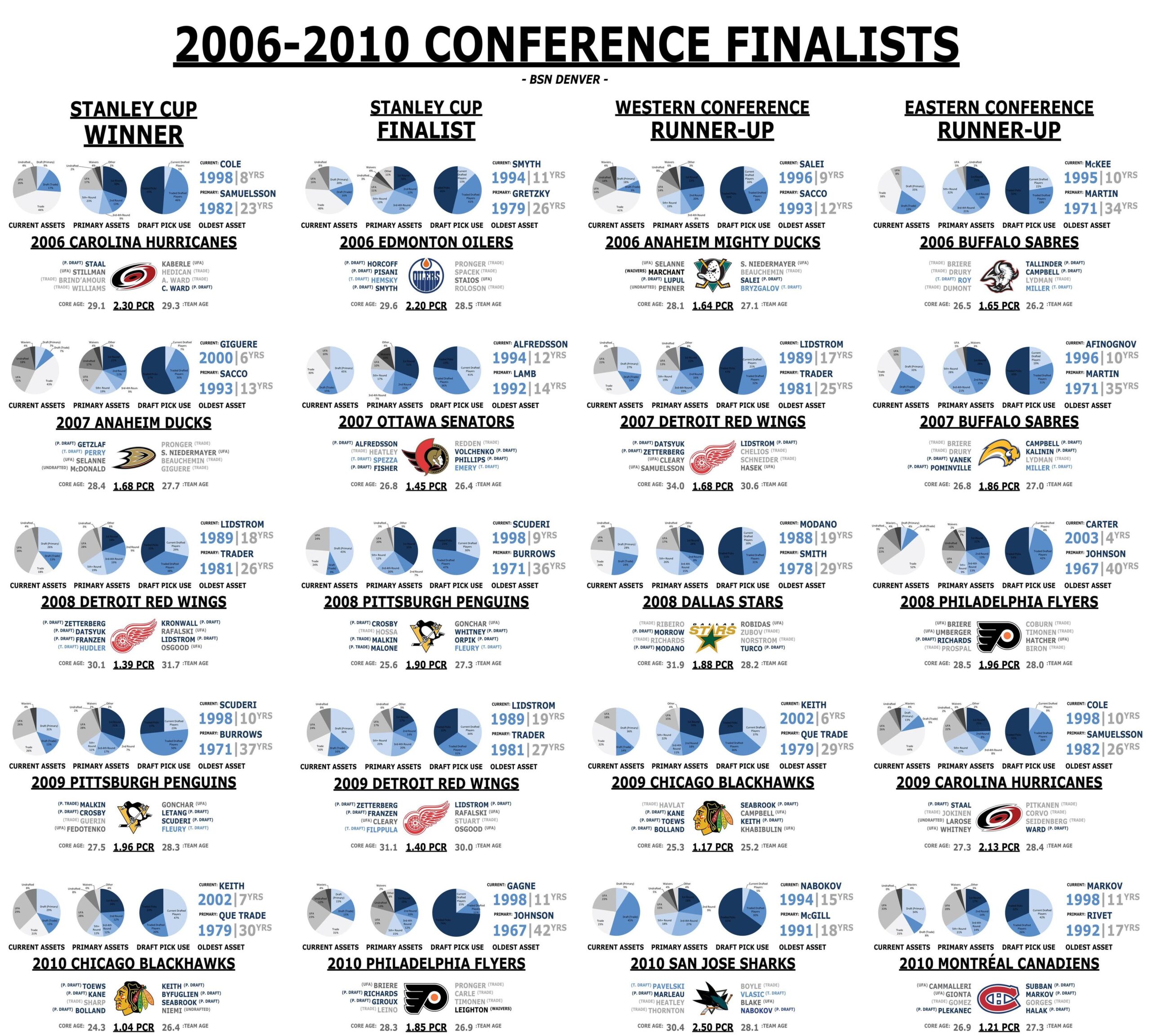
(Click Here for Full Size Image)
After the lockout, everything changed.
Some shifts happened almost instantly, while others slowly phased in as teams adjusted to the new rules. Gone were the days of free spending and buying contenders; front office strategy now needed to involve far more than simply planning massive trades. Certain organizations adapted quickly (or at least stumbled on smart formulas by accident), while others stubbornly stayed set in their ways and were left behind by the rest of the league. It was an age of innovation, of trial and errors, and the foundations for the strategies used today.
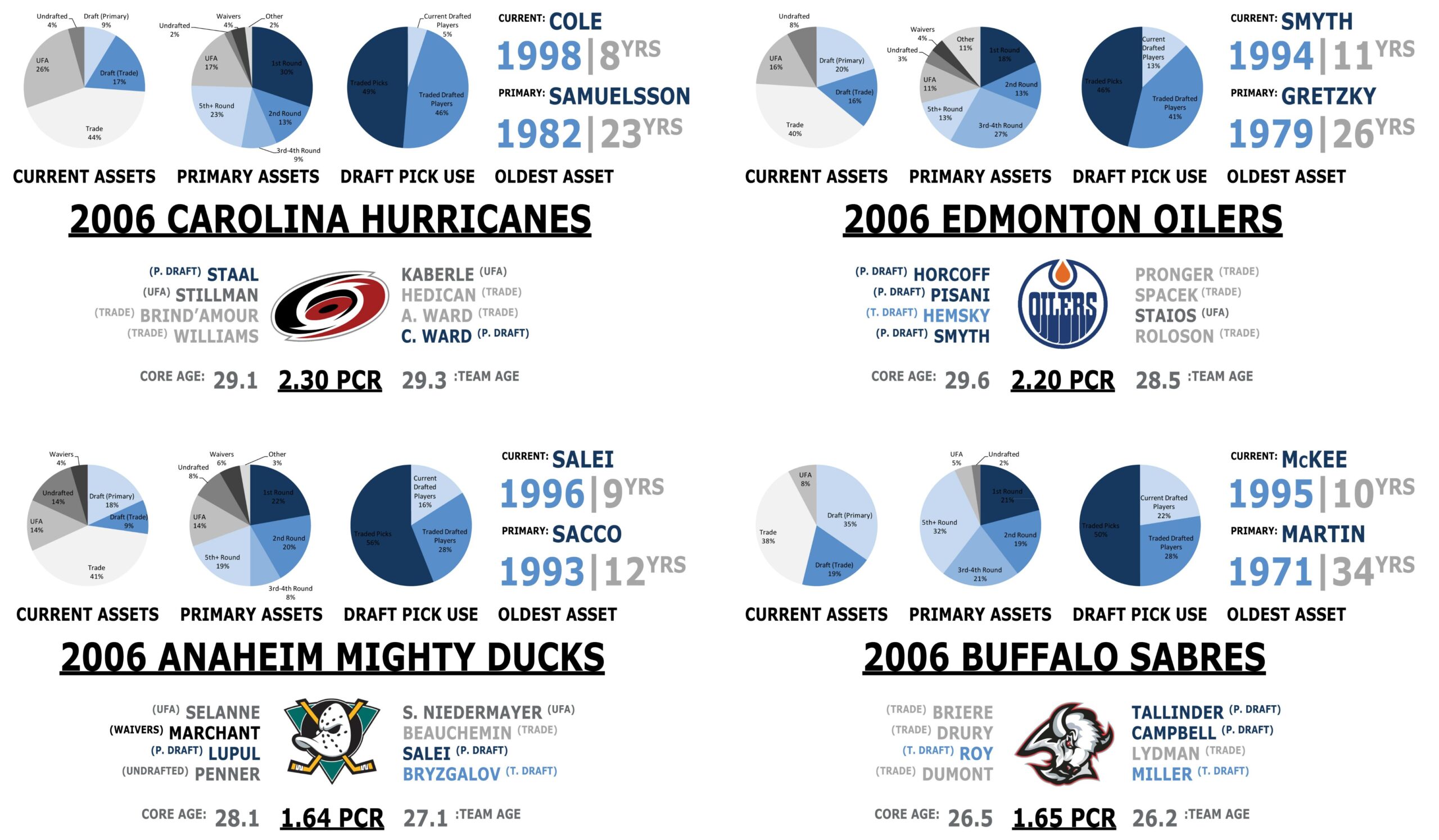
2006 Carolina Hurricanes Data Sheet
2006 Edmonton Oilers Data Sheet
2006 Mighty Ducks of Anaheim Data Sheet
2006 Buffalo Sabres Data Sheet
Even though it was bound to die, the trade era didn’t pass all at once. In fact, each of the teams involved in the 2006 (and most of those from 2007) could easily be classified as swap-based teams. However, it should be noted that of these four teams, all but the Mighty Ducks were in the bottom half of league spending the season before. This put them well under the new $39.9 million cap, meaning they didn’t have to shed salary to become compliant. As a result, their rosters stayed mostly intact through the transition, which helped them emerge competitive once play resumed.
They did have some help. Before the lockout, the only Cup teams that had dabbled much into UFA were Dallas and Detroit. Now, the glut of good players getting cut by teams for cap reasons made it easy for some of the little guys to sweep in and sign them to reasonable deals. Carolina in particular made use of this opportunity, bringing in four of their top ten playoff scorers using this method. It’s a big part of the reason why a team that hadn’t been in the playoffs for two years suddenly became the best in the land.
Unfortunately for Carolina, Buffalo, and Edmonton, this would mark one of their last times on this list. The Sabres would make the conference finals again in 2007, as would the Canes in 2009, but between those three clubs, they’ve had a total of four playoff seasons in the past nine years. As other teams adopted new strategies to stay competitive, the cores of these teams died and withered. Each are now marred in a long multi-year rebuild.
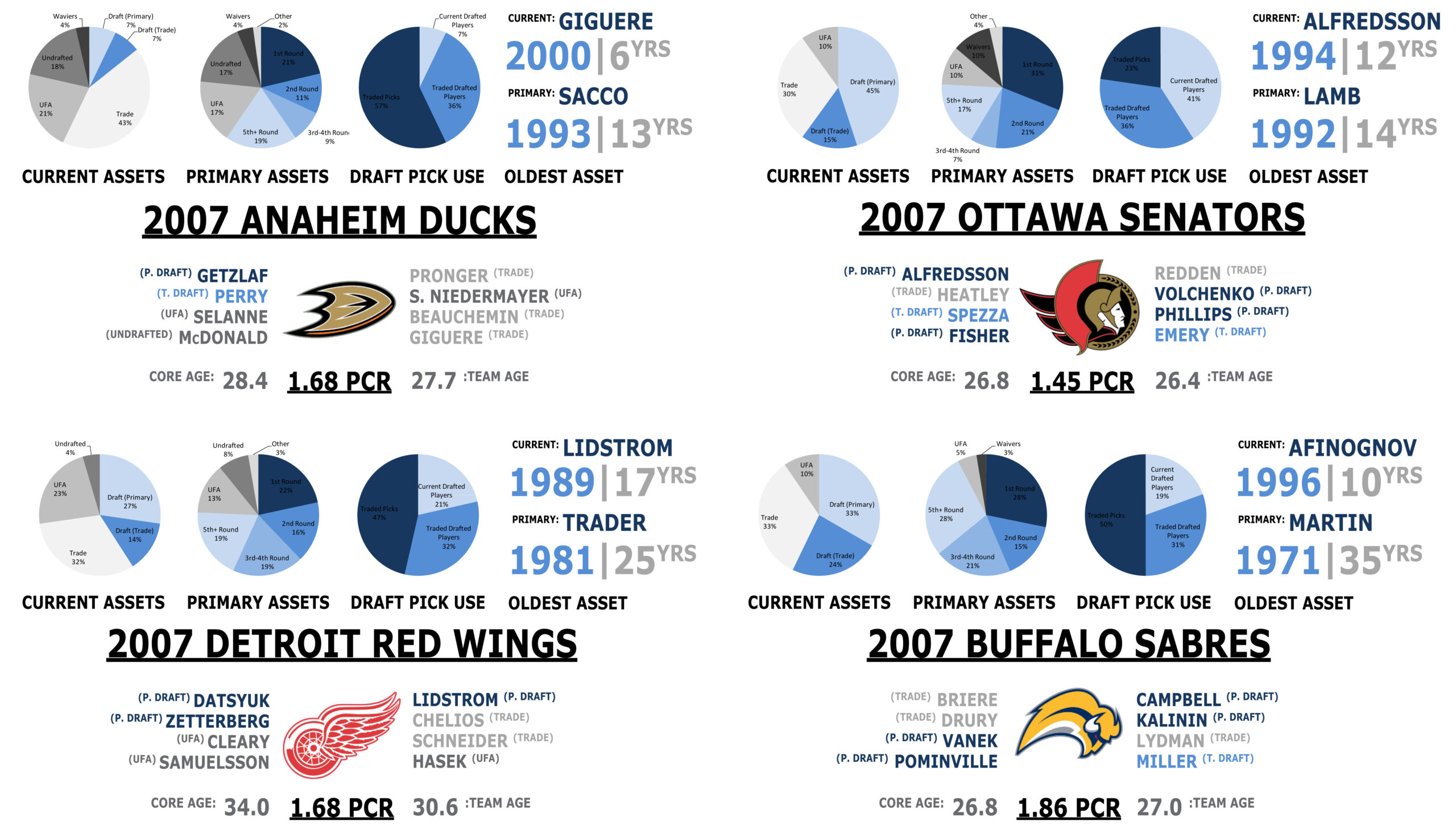
2007 Anaheim Ducks Data Sheet
2007 Ottawa Senators Data Sheet
2007 Detroit Red Wings Data Sheet
2007 Buffalo Sabres Data Sheet
Part of the downfall of trade-based teams was the rise of the draft. By 2007, two teams with nearly 60 percent drafted players arrived on the scene. Both did rely fairly heavily on trade, but they were still the pioneers in bringing back the methods on which the majority of teams are based today.
And no, it wasn’t Pittsburgh and Detroit. These teams, oddly enough, were Ottawa and Buffalo.
While it didn’t end up working out for them in the long haul, their small market status meant money was fairly tight even before the lockout. They couldn’t afford the SPEND SPEND SPEND method of the giants, so their rosters stayed much closer to the draft. Throughout the ’90s and early ’00s, both were fairly conscious of keeping their first round picks, so by 2007, many of those players were still with the team and in their primes.
Anaheim’s trade/UFA method did help win the Cup that year, but it wouldn’t be until 2011 that another trade-based team would lift the chalice. The draft-based Red Wings, Penguins, and Hawks would make sure of that.
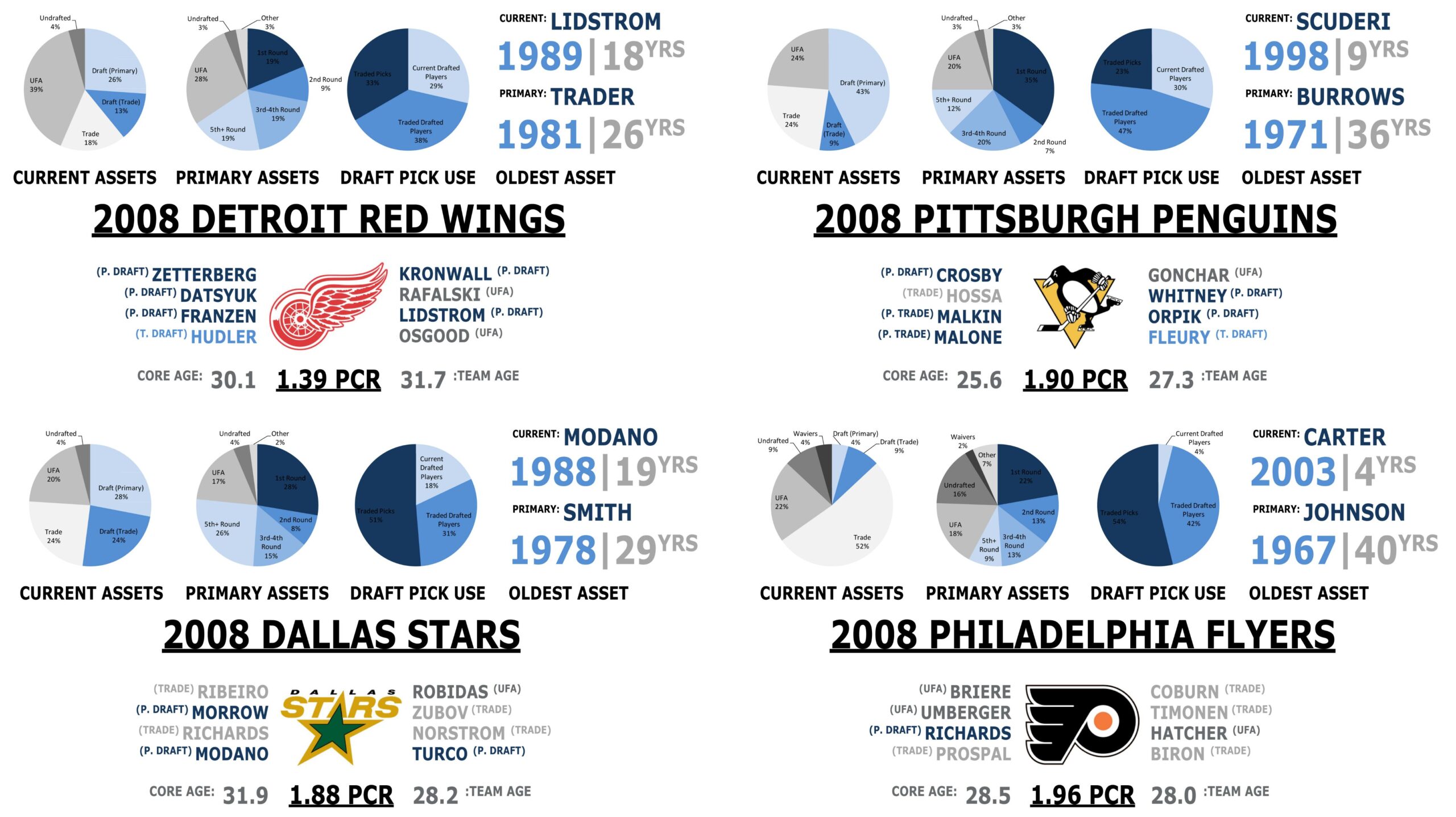
2008 Detroit Red Wings Data Sheet
2008 Pittsburgh Penguins Data Sheet
2008 Dallas Stars Data Sheet
2008 Philadelphia Flyers Data Sheet
In 2004, the situation for the Penguins and Wings couldn’t have been more different.
Pittsburgh was struggling after filing bankruptcy in 1995. While they had been the darlings of the early ’90s, their part in starting the arms race of that decade had taken a toll on their finances. Their payroll the season before the lockout was third lowest in the league, and their record was the absolute worst. Without the salary cap and a new arena, the team likely would have folded or moved to Kansas City within the next few years.
Detroit, on the other hand, was spending more on their hockey team than any other club in history. They were two years removed from a Stanley Cup and hoping for another one. Their second round exit to the Calgary Flames came as a surprise for a roster so laden with Hall of Fame talent, but the large market powerhouse’s reputation still remained intact.
Fast forward four seasons, and both of the teams had won a Cup. So, how did they do it?
The answer, for the most part, is the draft. While they weren’t quite as draft-heavy as Ottawa and Buffalo, six of their eight core players were developed in-house. Pittsburgh’s team also relied a bit on trades while Detroit cashed in on its reputation to create an army of UFAs, but both of the organizations built their rosters around young, new, cheap cores with a few carefully placed vets. They also address their needs by using players, not picks, as ammo for trades. In a number of ways, it was return to the mentality of the mid-’90s Winged Wheel that had been forgotten as the arms race intensified.
In the years since, Pittsburgh’s focus on the first round of the draft has proven much easier to replicate than Detroit’s mid- and late-round luck. Even so, both are critical precedents when it comes to understanding rebuilds in the cap era.
Dallas, another high-flyer before the lockout, also appears on this list with a strong number of draft picks. However, the majority of their core was acquired via trades and unfortunately was reaching the end of its prime by 2008. It would be six years before they made the playoffs again. Philadelphia would fair better, but their habit of trading draft picks would only get worse, helping lead to some of their problems today.
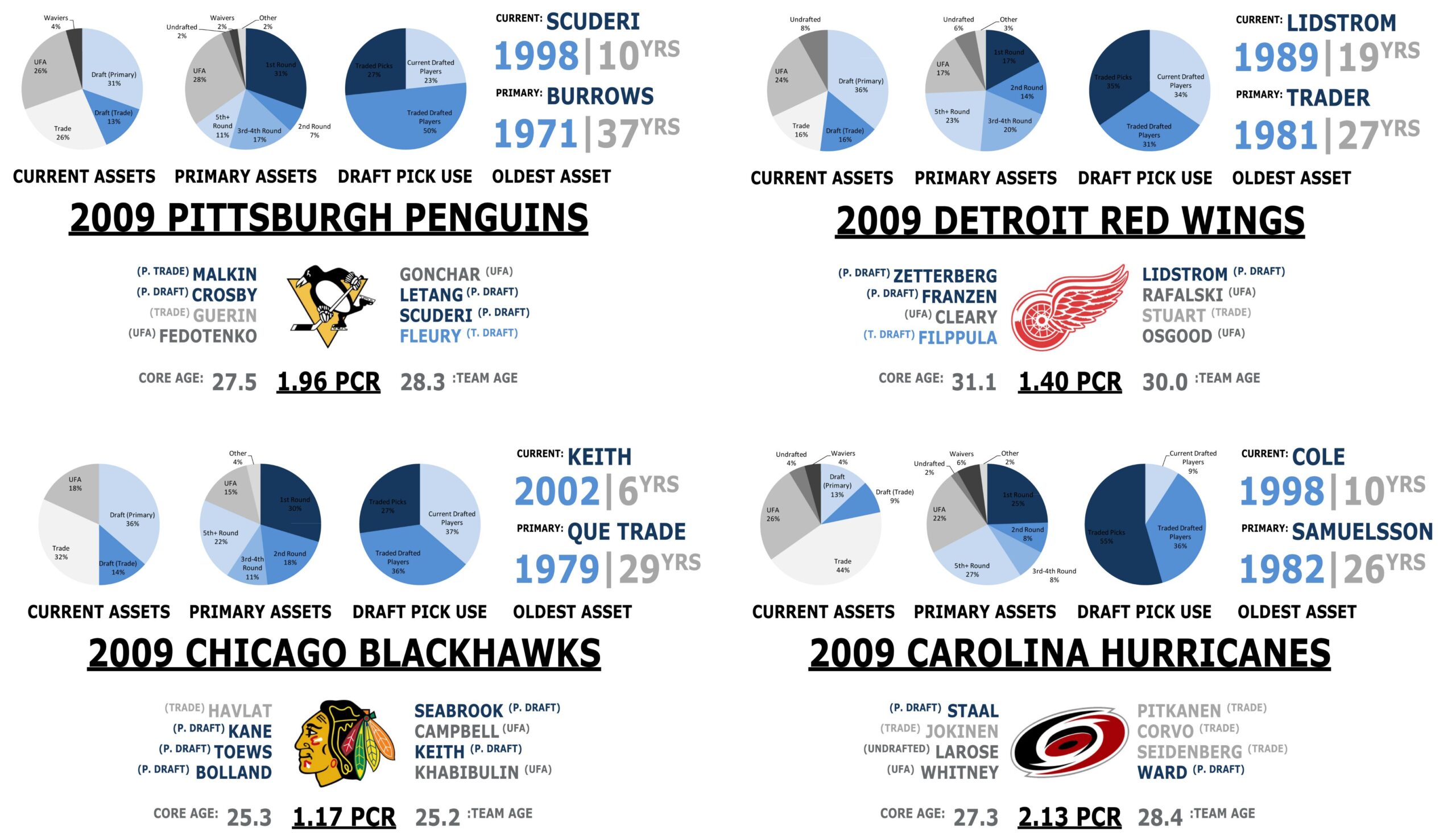
2009 Pittsburgh Penguins Data Sheet
2009 Detroit Red Wings Data Sheet
2009 Chicago Blackhawks Data Sheet
2009 Carolina Hurricanes Data Sheet
Pittsburgh gained their revenge on Detroit as the decade closed, and Carolina made one last run at another Cup before falling into a rebuild. However, perhaps the most important aspect of 2009 was the rise of the team that would place second in the West.
Much like the ’89 Flames and ’08/’09 Penguins, Chicago’s roster was based heavily in drafts and trades. However, unlike those teams, it lacked even a single long trade tree. Even though Troy Brouwer’s tree stretched back to 1979 and Havlat’s into the early ’80s, the Hawks were built on player-for-player hockey swaps that involved few traded draft picks. Their 23-man roster used only 27 primary assets, proving that successful teams could now be built from very little.
The other underrated part of that team was the series of drafts they had from 2002 to 2004. The high picks in ’06 and ’07 certainly cemented the core, but ’02 added Keith and Burish, ’03 saw Seabrook, Crawford, and Byfuglien, and ’04 included Barker, Bolland, and Brouwer. Most teams are lucky to get even one pick a year to the NHL, so to have a run of such incredible drafting is rare and notable. Hjalmarsson joined them in 2005, adding to an already very strong group of mid- to late-round gems.
By the time Toews and Kane showed up, Chicago was actually on the tail end of their rebuild. This is very different from the situation Pittsburgh found itself in while drafting Fleury first overall in 2003, and it’s also unusual considering the trade all the picks! mentality of the pre-lockout age. It was this luck, not the tanking, that truly set up Chicago’s rapid rise. Toews and Kane are likely the reasons why the team has won so many Cups, but without them, the Hawks still probably would’ve been a competitive group by 2009.
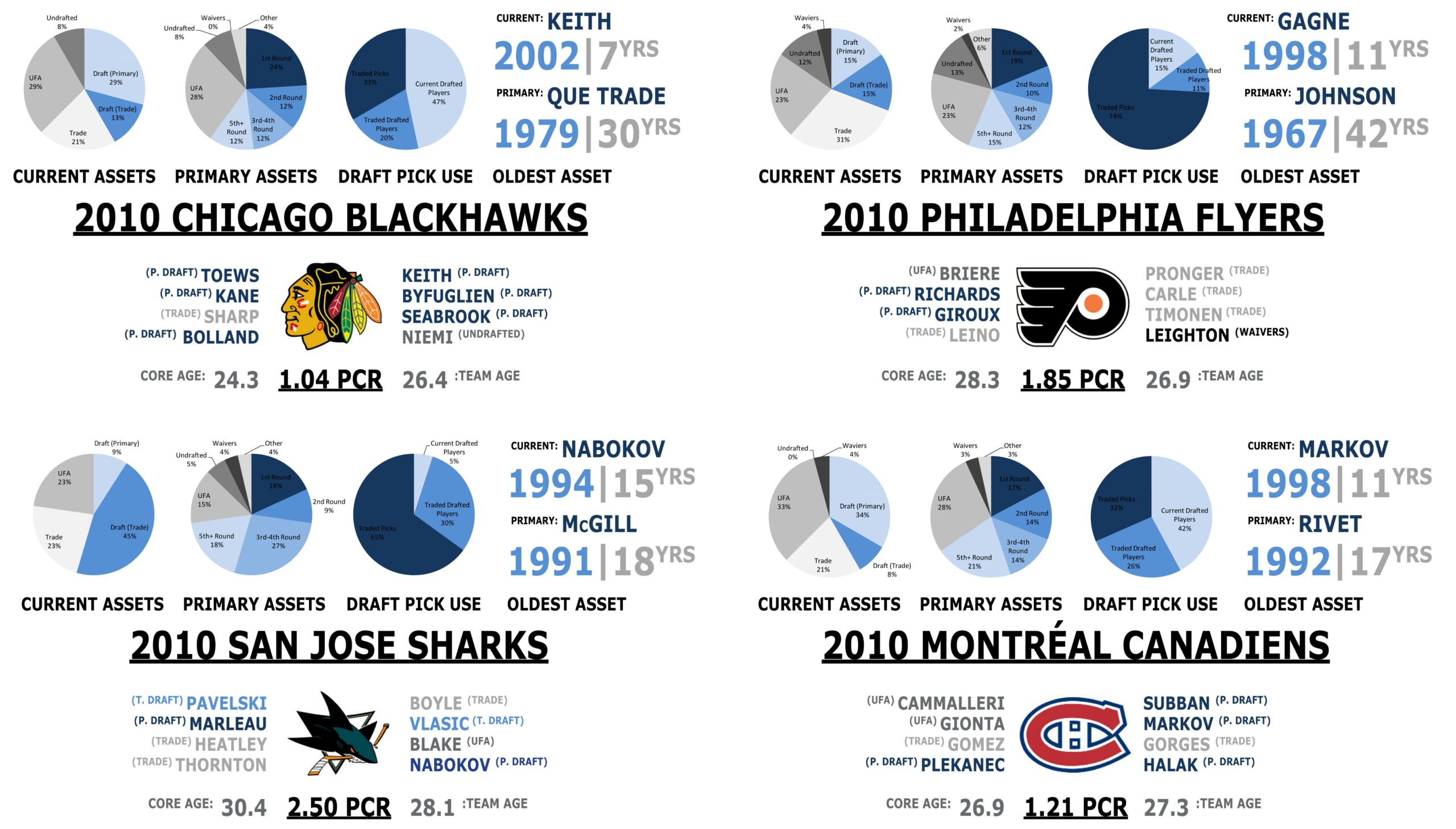
2010 Chicago Blackhawks Data Sheet
2010 Philadelphia Flyers Data Sheet
2010 San Jose Sharks Data Sheet
2010 Montreal Canadiens Data Sheet
2010 saw the surging Blackhawks win their first Cup. With their strong draft-based core in place, the Hawks added a series of five UFAs – including Marian Hossa – during the 2008 and 2009 summers that pushed them over the edge. One sneaky goal from Patrick Kane later, and it was hello Stanley for the formerly neglected team.
As mentioned above, the Flyer’s affinity for trading draft picks had reached an insane level. Their trade-based roster had been using them like candy since the early ’90s, as the last player on an active trade tree that had been drafted, developed, and then traded by the team was added in 1982. Since then, only 4 of the 24 picks still around had produced Flyers prospects, and each of those four were still on the roster. It’s not that Philadephia couldn’t draft well; it’s just that they didn’t give themselves much of a chance to do so. It almost paid off in 2010, but the dismantled farm system is a big part of why they’re currently struggling again.
The Shark’s roster shares much in common with the Canadiens of old. Both organization built competitive teams that leaned heavily on draft picks acquired via trade, but San Jose sent far more picks back the other way than Montreal ever did. When the Sharks traded up, they seemed to have much more luck than when they traded down, even though they made ample use of both. Short term UFAs were also a big part of their roster this year.
And Montreal? The modern version of the ancient franchise made some noise, even though their roster featured far more primary draft picks than secondary ones. Their forward corps was still a work in progress, but P.K. Subban was already making waves on their blueline. Like Chicago, their team was young and devoid of long trees, so nearly all trace of the previous Cups had been lost in the rebuild. However, strong drafts in 2003 and 2005, not to mention a large crop of 2009 UFAs, help the club get back on its feet.
Comments
Share your thoughts
Join the conversation



